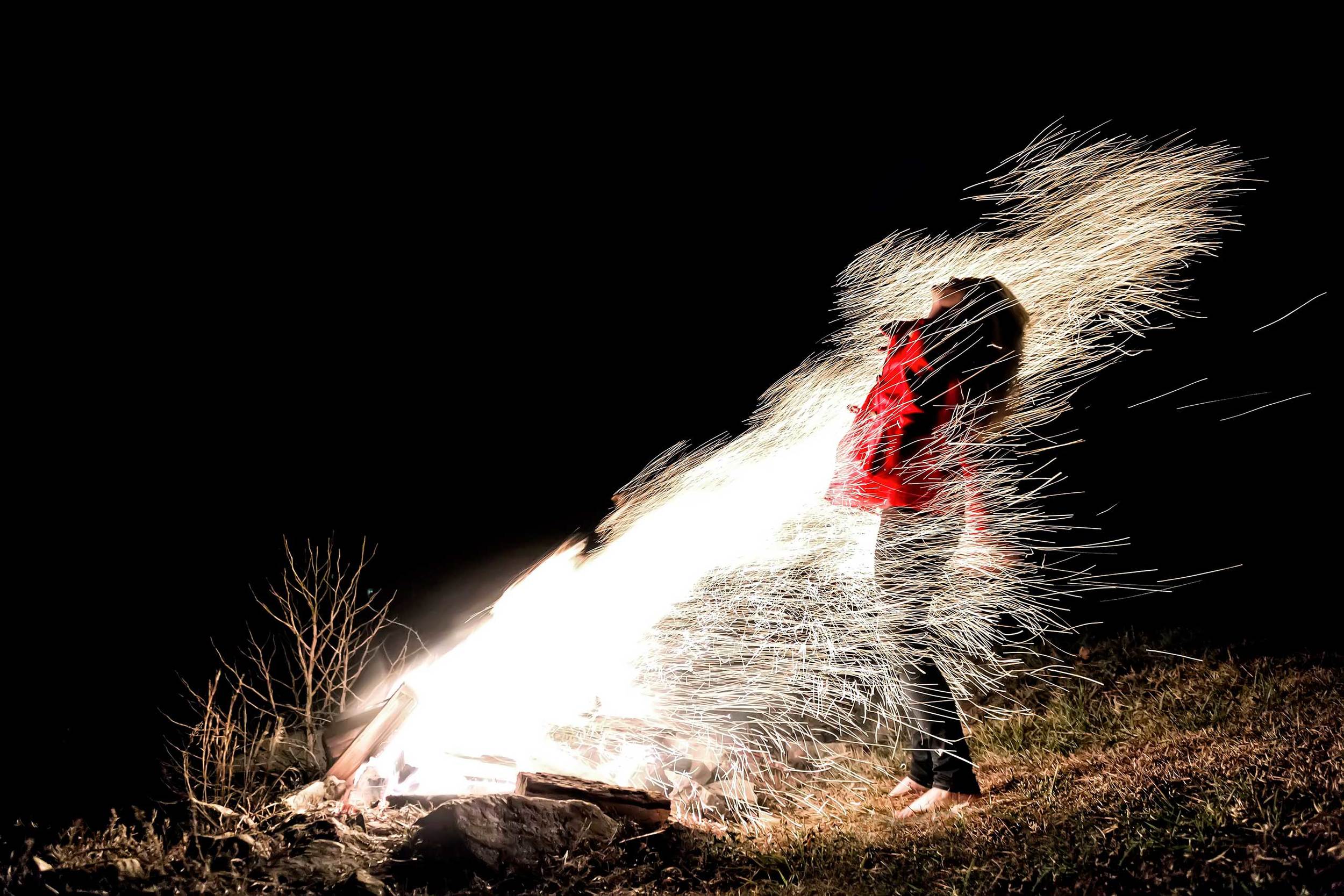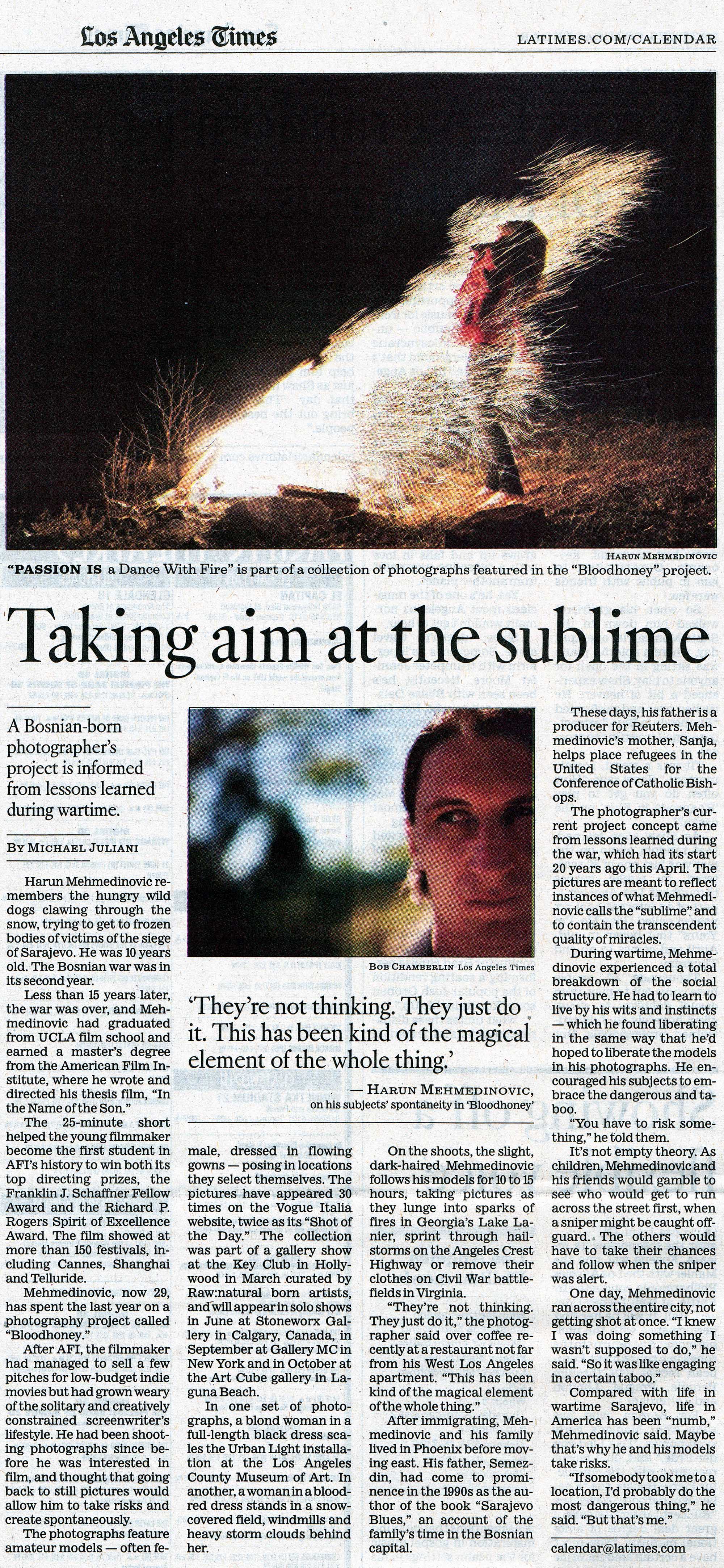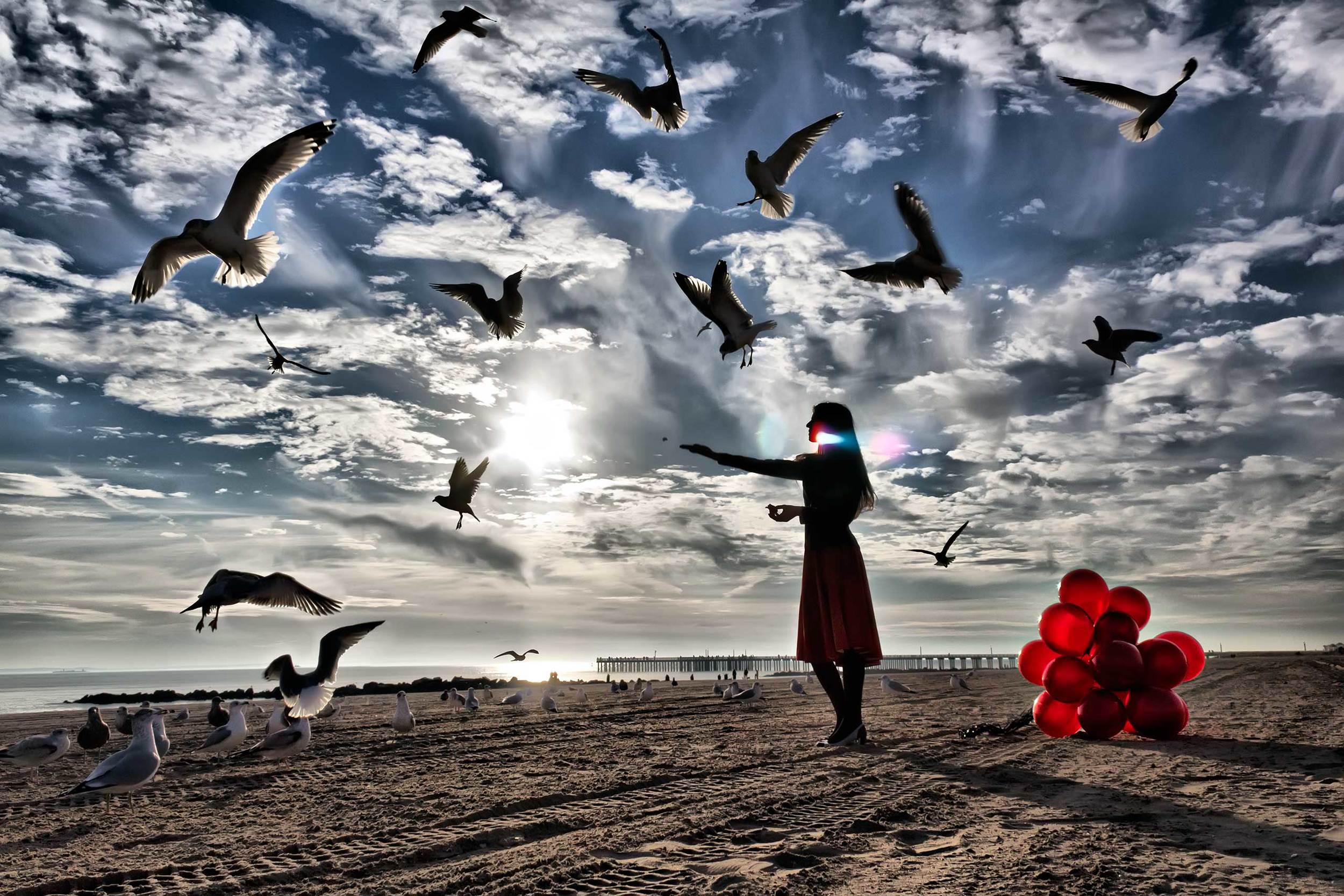Sarajevo-born and LA-based artist Harun Mehmedinović is most known for his short film “In the Name of the Son,” which follows a Bosnian-American refugee living in LA who confronts an enemy from the past who is asking him for help in committing suicide. The film won several awards and was selected for Cannes and Shanghai International Film Festivals. Mehmedinović has now shifted his focus to photography with his project “Bloodhoney” that features starkly beautiful and poetic pictures of individuals surrounded by environments that demand presence and interact and reflect with the subject’s subconscious. A psychological experiment, Mehmedinović talks about the ambitious agenda of Bloodhoney.
Dijana Kadic: You describe your project as “a narrative photography project that aims to strip away the subject’s persona and spontaneously captures a visual metaphor within a self-reflective, improvisational context.” Can you elaborate on this concept?
Harun Mehmedinović: Basically, all of humanity lives in [the structure of] 9am to 5pm. And when people live in structure, their days become predictable. There’s some kind of long-term goal where people are just moving towards something. But in reality, people become depressed and extremely stressed. They lose a flow with life. I’m interested in taking someone that’s in this maze and giving them a chance of a creative endeavor. I look at it as a psychological experiment.
DK: How do you go about this technically?
HM: I ask a person to pick a location from a gut level, somewhere they’d like to go. They pick their own clothes – things they feel comfortable in or maybe have some significance to them.
I want to put them in a different state of mind than they are every day. Usually people are fulfilling somebody else’s expectations in someone else’s system.
So when I put them into a different position, something might happen. They might do something they haven’t done in many years.
DK: How do you go about making something happen?
HM: The first thing they usually ask me is: “What should I do?” I always tell them we’ll see how things come to them. Let’s not force anything. After a while, they get bored or frustrated. You just see them walking around, not sure what to do. And this turns into infantile behavior, where they might pick up a stick and hit it on something, or they jump around. This behavior sometimes grows into something else. It leads to taking chances. For example, if a person is afraid to climb, they climb something. They start doing something dangerous and taking risks. When people get into that mode, that’s when they have a certain rush.
DK: How do people feel after they’ve been through this experience?
HM: Some of these shoots go to 12 or 13 hours. After we stop, they often tell me: “I’d love to do another 10 or 15 hours now.” They’re totally psychologically transformed by this experience, at least for that little bit of time. About half of these shoots, however, are too short to make any significant impact on a person. People don’t have the time.
DK: Did you have any major breakthroughs?
HM: I had people that did some extreme things [laughs].
DK: Like what?
HM: It was less a breakthrough and more doing something they just don’t do usually, such as taking their clothes off. Or they start screaming or doing something illegal.
DK: Who do you photograph?
HM: A lot of Gen Y’s – people born after the mid-70s or so. They’ve lived lives very much under control. From the beginning, everything was laid out. They were going to go to high school, then college, and then they were going to get a job. Well, there are not enough jobs out there. Most of the things they were told are not true.
DK: Your inspirations for this seem to be much more philosophical and literary in nature, above aesthetics. You’ve referenced Rumi, Joseph Campbell, and Hakim Bey. How does this translate to the visual arts?
HM: Ultimately, all visual arts have a certain story telling element. And sometimes this element can merely be to put people in a certain mood.
The reason I reference Campbell a lot is that he sees storytelling as two-fold. One part is rights of passage and the other is stories. Stories basically encourage people, that haven’t gone through certain rights of passage in life, to follow through on their own convictions or passions. Stories basically tell them that there was once somebody like you with this drive in them. They responded to their call to adventure and they found a piece of wisdom.
And Rumi is going to say that you need to just surrender yourself. Forget all the systems and everything around you and surrender yourself to passion.
DK: There are two things I notice about your project: most of your models are women and you seem to focus more on the environment than the subject itself.
HM: The kind of project I’m doing makes men really uncomfortable. I’ve certainly presented opportunities to men and I’m going to work consciously to get more men involved in this project. But men are extremely insecure. They may be secure in front of somebody else but to actually try to attempt something like this, to let go and open up, makes them feel very uncomfortable. And I don’t know the reasons why. [The project] is not sexual in nature. It’s not like they will embarrass themselves.
DK: Maybe they just have bigger egos than women.
HM: Ego is ultimately the left side of the brain – it’s the controlling side. They’re not letting go. And women are just more willing to. Women are more in tune with beauty, whether that is physical beauty or the sublime. And sublime is a big part of this project.
It’s the idea of man in nature, man versus nature, and nature as a more powerful element. It leaves a strong emotional resonance in us. […] It’s meeting something that is perceived to be more powerful than you.
DK: You’re in the process of working with a curator on an exhibition in New York. How are you going to present Bloodhoney?
HM: [Curating in a gallery] is a new experience for me. […] I’m not doing the art as social or moral action, where I’m immediately trying to get people to go change some bad systems. Rather, I’m trying to emotionally and spiritually engage people, whether they are people that are part of the project or people that are viewing the project. Not surprisingly, women tend to respond to the photos far more than men. And it’s not just because it’s mainly women that are depicted. There are plenty of photos that men masturbate to [laughs]. I think it’s the way that it’s shown.
I tend to keep my distance. I don’t encroach on the women in my photographs. They do what they want to do and I let them do it. So it’s not like fashion photography where I’m contorting them into positions.
DK: But you do have photos on Vogue Italia’s website. Does your work have a place in the fashion world?
HM: I had an opportunity to submit for Vogue and I said to myself: “Why not?” Although my photos are not what you’d think of when you think of Vogue, certain pictures evoke an emotional edge. When you look at some of the stuff in Vogue, especially Vogue Italia, they feature a lot of feminine leaning emotional material. It’s things that would appeal to women more in a sensual basis.
What I’m photographing is not something to see on the street every day, like sexualized pictures of women or pets. So most people who will respond to my project are people who are more in tune with their emotions, which is usually women, [and that’s Vogue’s target audience].
DK: What are some pictures that have evoked the most responses?
HM: My friend left a comment [on Facebook] once saying that these women are so unapologetic and raw. She used the word “divine feminine.” Does that mean unprocessed feminine? Free feminine? The idea that these women do what they want and seem to have no fear in some of these images? They’re hovering over abysses and other high places. These are images that in a certain sense could take your breath away – in a sense where you put yourself in their shoes.
Most photographers shove their camera in the subject’s face. They’re literally using the camera as an extension of their penis. I don’t let those women be dominated or sexualized. It’s about submitting yourself to that moment and taking your ego out of the equation.
DK: I have noticed this about your photographs. Even with nude models, there’s no sexual connotation whatsoever.
HM: There’s something about the choice of where you are with that camera – how close you are, how extenuated certain things are. What are you really putting the focus on?
A key distinction of how I approach what I do is that I see my models as subjects, not objects. The difference is a simple one. A model who is an object works to cater to the photographer, a subject is there to be catered to by the photographer.
DK: So you’re providing a service to them instead of them providing a service to you?
HM: Yeah, I guess you could say that.
Link: http://artumjetnost.wordpress.com/2012/02/26/photographyescaping-the-maze/





